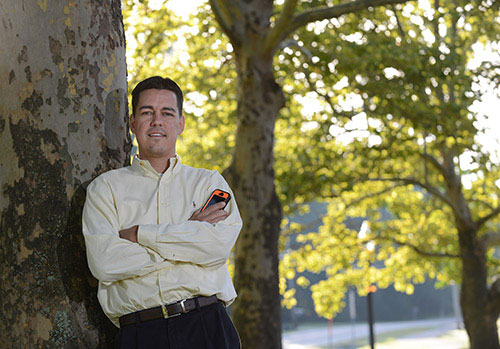Researchers Develop Mobile App for National Park
A $952,000 National Science Foundation grant to researchers at ║┌┴¤│ď╣¤═° will result in a mobile device application to help visitors to Cuyahoga Valley National Park learn more about the parkÔÇÖs history and ecology and become ÔÇťcitizen scientistsÔÇŁ by sharing their findings with others.
The grant to a team of researchers led by Richard E. Ferdig, Ph.D., professor in the Research Center for Education Technology in the College of Education, Health and Human Services at ║┌┴¤│ď╣¤═°, will be used to create a mobile app with multiple features, including an interactive map of the park featuring ÔÇťpop-upsÔÇŁ of wildlife, plants and geological formations typically seen in the areas they are visiting.
The app will also allow visitors to look up specimens in a database, take pictures of what they see in the park and get help identifying unknown objects. They will be able to use GPS to follow ÔÇťadventure trailsÔÇŁ through the park to locate and learn about key features of its geology, habitats and history.
The main goals of the project are to explore the feasibility of using GPS-based mobile devices for informal science learning and to understand the impact of such technology.
ÔÇťWeÔÇÖre really interested in advancing informal science learning in the park while also getting people involved in citizen science ÔÇô a process where they contribute to our scientific understanding of the environment,ÔÇŁ said Ferdig.
Log In and Locate Wildlife
Users of the app may also choose to log in and save their findings, creating a record of their discoveries that they can use to plan future visits. Park visitors could also use the app to participate in wildlife counts, showing the place and location where they spot deer, for instance, or where they spot a migrating bird.
The app will work on Apple and Android products, the bulk of the mobile market. Mobile devices will be available for visitors to check out at the park, or visitors can use the app on their own smartphones or devices. The app will not require a wireless connection but will rely on the devicesÔÇÖ built-in GPS.
More than 2.5 million people each year visit CVNP, and visitors make about 110,000 requests of rangers and volunteers for on-the-spot information about its wildlife and resources. As part of the project, funding will be provided to the National Park Service for two seasonal employees to help test and implement the app in CVNP.
ÔÇťCuyahoga Valley National Park preserves 33,000 acres of natural open space. It provides an ideal place for learning about science in a fun and appealing setting,ÔÇŁ said Jennie Vasarhelyi, chief of interpretation, education and visitor services at CVNP, who will be the lead representative for the park. ÔÇťWe are very pleased that ║┌┴¤│ď╣¤═° is leading this project to create new ways for visitors to engage with science while visiting the park.ÔÇŁ
The researchers, who include a biologist, a computer scientist, and Ferdig, an educational psychologist, will survey users to find out how much they have learned, their attitudes toward personal learning and what interests them.
While CVNP will be the ÔÇťlabÔÇŁ for the three-year project, the app could eventually be used in other parks around the world that develop their own databases of content.
Ferdig, principal investigator on the grant, is the Summit Professor of Learning Technologies and Professor of Instructional Technology in the College of Education, Health and Human Services at ║┌┴¤│ď╣¤═°. He focuses on innovative learning through technologies and is the founding editor of the International Journal of Gaming and Computer Mediated Simulations.
Other ║┌┴¤│ď╣¤═° researchers contributing research on the grant project are Annette Kratcoski, Ph.D., director of the Research Center for Educational Technology, and Ruoming Jin, Ph.D., associate professor in the Department of Computer Sciences in the College of Arts and Sciences. Biologist Patrick D. Lorch, formerly at ║┌┴¤│ď╣¤═°, is now manager of field research for Cleveland Metroparks.

